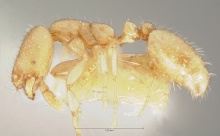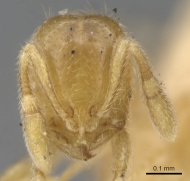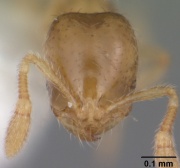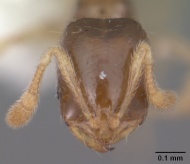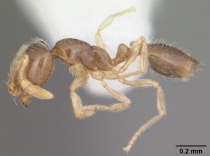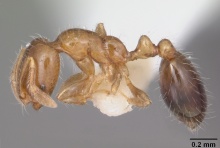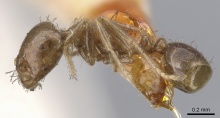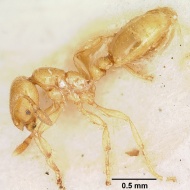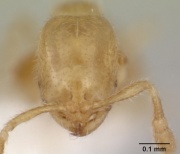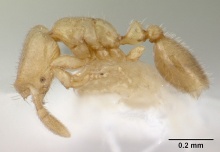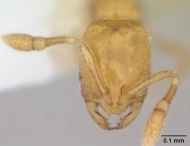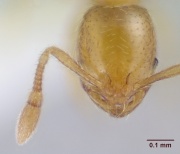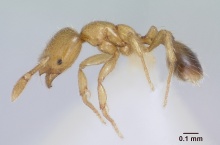Key to Solenopsis molesta species complex
The following is based on: Pacheco, J.A. & Mackay, W.P. 2013. The systematics and biology of the New World thief ants of the genus Solenopsis (Hymenoptera: Formicidae). Edwin Mellen Press, Lewiston, New York. 501 pp. PDF
The molesta species complex is a group of New World thief ants in the genus Solenopsis.
There are two keys to workers. The northern species, which follows just below, and a South American key that is found further down the page.
You might also be interested in
.
Key to workers (north of Colombia) of species of the molesta Complex
1
- Relatively large, total length 1.4-2.0 mm, head length 0.40-0.54 mm; concolorous yellow to black; moderately hairy; cephalic punctures fine to semicoarse; clypeal teeth less developed, typically lateral teeth angulate (occasionally bent inward) or reduced; eye with 3-5 ommatidia; head quadrate to slightly elongated; scape relatively long, 0.28-0.40 mm; minor funicular segments relatively long, 0.12-0.18 mm; mesopleuron occasionally striated, metapleuron always striated; posterior propodeal margin rounded; petiolar peduncle typically with ventral tooth; posterior tibiae with erect to suberect hairs . . . . . 2 (molesta subgroup)
- Smaller; total length 1.0-1.5 mm; head length 0.32-0.44 mm; concolorous yellow; very pilose; cephalic punctures always fine; clypeal teeth more developed, typically lateral teeth angulate to well developed; eye usually smaller, with 3-5 ommatidia; head quadrate; scape length shorter 0.21-0.30 mm; minor funicular segments relatively short, 0.08-0.12 mm; mesopleuron without sculpturing , always smooth and shiny; metapleuron typically striated; posterior propodeal margin rounded to angulate; petiolar peduncle with or without ventral tooth; posterior tibiae typically with appressed hairs (with few suberect hairs) . . . . . 9 (pollux subgroup)
- Smaller, total length 1.0-1.6 mm, head length (0.30-0.46 mm); concolorous yellow to medium brown; sparsely to moderately pilose; cephalic punctures always fine; clypeal teeth less developed, typically lateral teeth reduced to angulate; eye 3-7 ommatidia; scape length 0.22-0.30 mm; minor funicular segments relatively short, 0.08-0.12 mm; mesopleuron without sculpturing, always smooth and shiny; metapleuron typically striated); posterior propodeal margin typically rounded (few exceptions of being angulate); petiolar peduncle lacking ventral tooth; posterior tibiae typically with appressed hairs (with few sub erect hairs) . . . . . 14 (tenuis subgroup)
2
return to couplet #1
- North America primarily, central to northern Mexico north to southern Canada (Ontario); concolorous yellow to dark brown, total length 1.4-1.8 mm; lacking sculpturing on mesopleuron; petiolar peduncle nearly always with ventral tooth (typically well developed, but can be reduced) . . . . . 3
- Central and South America predominantly, southern Mexico (Veracruz and Hidalgo) south to northern Argentina (Buenos Aires); yellow to black, occasionally pale brown with yellow appendages; total length 1.4-2.0 mm; mesopleuron typically horizontally striated (but can be absent); petiolar peduncle usually lacking ventral tooth . . . . . 7
3
return to couplet #2
- Larger, total length 1.5-1.8 mm; head length 0.45-0.5 mm, head width 0.38-0.43; dark yellow to dark brown; space between tips of lateral clypeal teeth wider than 0.09 mm ; found in ponderosa pine forests under rocks; rare; southwest USA (California, Colorado, Arizona, New Mexico, Coahuila Mexico) south to central and western Mexico . . . . . Solenopsis validiuscula
- Smaller, total length 1.4-1.6 mm, head length 0.41-0.5 mm, head width 0.36-0.43; pinkish yellow to pale brown; space between tips of lateral clypeal teeth narrower (always less than 0.09 mm); found in a variety of habitats, in soil to under rocks, etc.; common; widely distributed, southern Canada to California south to central Mexico . . . . . 4
4
return to couplet #3
- Gaster of female concolorous pink (living) to pale yellow (preserved); scape of worker shorter, ~0.28 mm; minor funicular segments shorter, ~0.11 mm; eye with 5 ommatidia; posterior propodeal margin slightly angulate; known only from Pe1ee Point and Pelee Island, Ontario, Canada . . . . . Solenopsis rosella
- Female and worker concolorous yellow to pale brown, gaster nearly always yellow; scape longer, 0.28-0.35 mm; minor funicular segments longer, 0.11-0.16 mm; eye with 3-5 ommatidia; posterior propodeal margin rounded; widely distributed, most of continental USA (New York to California) and Mexico . . . . . 5
5
return to couplet #4
- Extensive range, most of continental USA (New York to California) to Mexico; head larger, length 0.42-0.51 mm; width 0.36-0.43 mm; minor funicular segments longer, 0.13-0.15 mm; lateral clypeal teeth angulate to well developed (never turned inward); posterior tibiae with mostly sub erect to erect hairs; common . . . . . Solenopsis molesta
- Restricted range, southwestern USA to Mexico; head smaller, length 0.41-0.45 mm, width 0.34-0.39 mm; minor funicular segments shorter, 0.11-0.13 mm; lateral clypeal teeth angulate (often blunt and turned inward); posterior tibiae with appressed to suberect hairs . . . . . 6
6
return to couplet #5
- Concolorous yellow; lateral clypeal teeth angulate, never turned inward; female golden brown, with 4 well developed clypeal teeth, coarse cephalic and pronotum punctures, frontal lobes and anterior border of head between frontal lobes and eye vertically striated; petiole and postpetiole with horizontal striae restricted to basal areas; known only from New Mexico . . . . . Solenopsis quadridentata
- Concolorous yellow to pale brown; lateral clypeal teeth typically blunt (can be angulate) and turned inward; female medium brown, with well developed lateral teeth and reduced bumps at extralateral position, frontal lobes striated vertically striated; sides of petiole and postpetiole entirely horizontally striated; found in Texas, New Mexico and Mexico . . . . . Solenopsis salina
7
return to couplet #2
- Mesopleuron without sculpturing although metapleuron horizontally striated; Belize to Brazil . . . . . Solenopsis laeviceps
- Mesopleuron and metapleuron striated . . . . . 8
8
return to couplet #7
- Smaller, total length 1.4-1.6 mm; head length 0.42-0.43 mm; eye length 0.03-0.36 mm; minor funicular segments shorter, 0.12-0.14 mm; concolorous yellow; Central America (Costa Rica) . . . . . Solenopsis striata
- Larger, total length 1.4-2.0 mm, head length 0.40-0.54 mm; eye length 0.04-0.06 mm; minor funicular segments longer, 0.12-0.18 mm; concolorous dark brown to black (occasionally bicolored, light brown with dark brown gaster); widely distributed from Mexico to Argentina . . . . . Solenopsis picea
9
return to couplet #1
- Common or part of range in Caribbean or Florida; worker generally with more than 10 erect hairs on the dorsum of promesonotum (seen in profile) . . . . . 10
- Not ranging into Caribbean or Florida; worker generally with fewer than 10 erect hairs on dorsum of promesonotum (in profile) . . . . . 12
10
return to couplet #9
- Common in Florida based on material examined (likely to be in surrounding states); posterior tibial hairs mostly appressed . . . . . Solenopsis abdita
- Common in Caribbean, Mexico south to Colombia, not found in Florida; posterior tibial hairs mostly suberect . . . . . 11
11
return to couplet #10
- Head and pronotum with fine punctures, difficult to see; head larger, cephalic index 88-134; minor funicular segments longer, 0.08-0.11 mm; notopropodeal suture well depressed; female smaller (Total Length < 3 mm) and dark brown; Puerto Rico . . . . . Solenopsis maboya
- Head and pronotum with conspicuous, semi-coarse punctures head smaller and narrower, cephalic index 78; minor funicular segments short, ~0.08 mm; notopropodeal suture weakly depressed; female larger (TL > 3 mm ) and yellowish brown or pale brown; Caribbean, central Mexico south to Colombia . . . . . Solenopsis pollux
12
return to couplet #9
- Petiolar peduncle lacking tooth or flange ventrally; smaller, total length, ~1.0 mm; smaller head, maximum cephalic index 82; female black; uncommon, Mexico (Tabasco) . . . . . Solenopsis patriciae
- Petiolar peduncle with tooth or flange ventrally; larger, total length, 1.2-1.5 mm; larger head, maximum cephalic index 90; widely distributed (North Carolina to Colombia) . . . . . 13
13
return to couplet #12
A queen is usually necessary to correctly identify these species where the distributions overlap.
- United States, southernmost part of distribution, in Texas; worker: hairs of posterior tibia mostly suberect; female: larger, total length 4.1-4.2 mm; yellow to pale brown; eye larger, length ~0.24 mm, width 0.18-0.19 mm . . . . . Solenopsis carolinensis
- North America to South America, southernmost part of distribution, Colombia; worker: hairs of posterior tibiae mostly appressed; female: smaller, total length 3.1-3.8 mm, dark brown; eye smaller, length 0.17-0.20 mm, width 0.15-0.16 mm . . . . . Solenopsis texana
14
return to couplet #1
- Restricted range, continental USA, Florida through Gulf states to southern Texas (Victoria); medium brown to dark brown, usually bicolored (darker body with lighter appendages or lighter body with darker gaster); maximum total length 1.5 mm, posterior propodeal margin rounded or slightly angulate . . . . . 15
- Widely distributed, not in continental USA, Mexico, Caribbean, south to Argentina; concolorous yellow to dark brown (if bicolored, with lighter appendages); maximum total length 1.6 mm; posterior propodeal margin always rounded . . . . . 16
15
return to couplet #14
- Moderately hairy; medium brown with yellowish appendages; posterior propodeal margin rounded; minor funicular segments longer, 0.1-0.12 mm; known only from Florida . . . . . Solenopsis nickersoni
- Not very pilose; concolorous dark brown or bicolored reddish brown with dark brown gaster; posterior propodeal margin slightly angulate; minor funicular segments shorter, 0.90-0.96 mm; ranging from Florida through Gulf states to Texas . . . . . Solenopsis picta
16
return to couplet #14
- Partial range in the Caribbean; concolorous yellow to medium brown (if bicolored with lighter appendages) . . . . . 17
- Does not range in the Caribbean; concolorous yellow to pale brown (never bicolored) . . . . . 19
17
return to couplet #16
- Medium brown with lighter appendages; scape longer, minimum length 0.29 mm; minor funicular segments longer, minimum length 0.12 mm; Mexico to Panama, Caribbean . . . . . Solenopsis castor
- Yellow to golden yellow; scape shorter, 0.22-0.29 mm; minor funicular segments shorter, 0.08-0.12 mm . . . . . 18
18
return to couplet #17
- Worker: Lateral clypeal teeth more developed, sharp; concolorous yellow to golden yellow; female: golden brown, with well-defined clypeal carinae; petiolar peduncle with thin flange present ventrally; eye smaller, length 0.14-0.19 mm, width 0.11-0.16 mm; Mexico to Brazil, Caribbean . . . . . Solenopsis corticalis
- Worker: Lateral clypeal teeth less developed, angulate; concolorous yellow; female: pale yellow, with weakly defined clypeal carinae; petiolar peduncle without flange ventrally; eye larger, length ~0.192 mm, width ~0.16 mm; Mexico to Colombia, Caribbean . . . . . Solenopsis zeteki
19
return to couplet #16
- Worker, Eye larger, oval, length 0.04-0.05 mm, width 0.03-0.04 mm, with 5-7 ommatidia; concolorous pale to medium brown; Female, medium brown; lateral clypeal teeth poorly defined; cephalic punctures fme, with frontal lobes vertically striated (striae restricted to lobes and do not extend posteriorly on head); Mexico to Argentina . . . . . Solenopsis tenuis
- Worker, eye smaller, circular length 0.03-0.04 mm, width 0.02-0.03 mm, with ~3 ommatidia; concolorous yellow; Female, golden brown, lateral clypeal teeth well developed; cephalic punctures coarse, with frontal lobes vertically striated (with striae extending posteriorly on head to vertex); Mexico to Panama . . . . . Solenopsis conjurata
Key to workers of South American species of the molesta complex
1S
- Relatively larger, total length 1.3-2.5 mm, head length 0.4-0.6 mm; concolorous yellow to dark brown, occasionally bicolored yellow and brown; moderately hairy; cephalic punctures fine; clypeal teeth less developed, typically lateral teeth angulate; eye with 3-10 ommatidia (typically 3-5), oval or kidney-shaped; head quadrate to slightly elongated; scape relatively long, 0.27-0.40 mm; minor funicular segments relatively long, typically greater than 0.12 mm; mesopleuron occasionally striated, metapleuron always striated; posterior propodeal margin rounded; petiolar peduncle typically with ventral tooth or bump; posterior tibiae with erect to suberect hairs . . . . . 2S (molesta subgroup)
- Smaller, total length 1.1-2.2 mm; head length 0.3-0.6 mm; concolorous yellow; very pilose; cephalic punctures fine to semi-coarse; clypeal teeth more developed, typically lateral teeth angulate to well developed; eye usually smaller, with 3-10 ommatidia (typically 1-5), oval or circular; head quadrate; scape length shorter 0.24-0.40 mm (typically less than 0.4 mm); minor funicular segments relatively short, typically less than 0.12 mm; mesopleuron without sculpturing, always smooth and shiny; metapleuron typically striated; posterior propodeal margin rounded to angulate; petiolar peduncle with or without ventral tooth; posterior tibiae typically with appressed hairs (with few suberect hairs) . . . . . 13S (pollux subgroup)
- Smaller, total length 1.0-1.6 mm; head length (0.30-0.46 mm); concolorous yellow to medium brown; sparsely to moderately pilose; cephalic punctures always fine; clypeal teeth less developed, typically lateral teeth reduced to angulate; eye with 3-7 ommatidia, oval or almondshaped; scape length 0.22-0.30 mm; minor funicular segments relatively short, 0.08-0.12 mm; mesopleuron without sculpturing, always smooth and shiny; metapleuron typically striated; posterior propodeal margin typically rounded (few exceptions of being angulate); petiolar peduncle always missing ventral tooth (occasionally with bump) (see sulfurea); posterior tibiae typically with appressed hairs (with few suberect hairs) . . . . . 17S (tenuis subgroup)
2S
return to couplet #1S
- Relatively larger, total length often greater than 2.0 mm (typically 1.7-2.5 mm); head longer, 0.4-0.6 mm; scape longer, 0.3-0.4 mm; minor funicular segments longer, often 0.15-0.18 mm; concolorous yellow to black (rarely bicolored); petiolar peduncle typically with ventral tooth; mesopleuron commonly striated; mainly occurring in South America (Argentina, Brazil, Chile, Paraguay) (infrequently ranging through Central America to Mexico, never in Caribbean) . . . . . 3S
- Smaller, never greater than 2.0 mm (typically 1.5-1.7 mm); head shorter, 0.4-0.5 mm; scape shorter, 0.27-0.38 mm; minor funicular segments shorter, often 0.12-0.15 mm; concolorous yellow to pale brown (commonly bicolored, yellow or orange with brown gaster); petiolar peduncle typically lacking ventral tooth (occasionally bump present); mesopleuron rarely striated; generally from South America (Argentina, Brazil, Colombia) (more frequently ranging through Central America to Mexico, can be found in Caribbean) . . . . . 8S
3S
return to couplet #2S
- Mesopleuron horizontally striated; widely distributed, Mexico south to Argentina . . . . . 4S
- Mesopleuron lacking sculpturing, always smooth and shiny; restricted to South America (Argentina, Brazil, Paraguay, Uruguay) . . . . . 7S
4S
return to couplet #3S
- Concolorous yellow; eye larger, 8-10 ommatidia, eye length up to 0.07 mm; medial clypeal bump commonly found between lateral teeth; southern Brazil, Paraguay, northern Argentina . . . . . Solenopsis joergenseni
- Concolorous golden brown to black; eye smaller, 3-5 ommatidia, eye length up to 0.06 mm; medial clypeal bump never present on anterior clypeal margin . . . . . 5S
5S
return to couplet #4S
- Postpetiole globose, greatly dilated viewed laterally and dorsally (resembling members of the globularia species complex); frontal lobes vertically striated; eye with 3 ommatidia; petiolar peduncle without ventral tooth or flange; southern Brazil, Argentina and Paraguay . . . . . Solenopsis loretana
- Postpetiole oval (not globose or dilated), nearly equal in size to petiole viewed laterally, slightly wider viewed dorsally; frontal lobes lacking striae; eye with 3-5 ommatidia; petiolar peduncle occasionally with small ventral bump . . . . . 6S
6S
return to couplet #5S
- Concolorous dark brown to black (occasionally bicolored); lateral clypeal teeth reduced, angulate; petiolar peduncle lacking ventral tooth or bump; female smaller, 4.0-4.7 mm, head shorter 0.67-0.7 mm, narrower 0.6-0.7 mm; vertical striae on frontal lobes extending from lobes posteriorly on dorsum of head; male larger, total length ~3.5, head longer ~0.6 mm, wider ~0.64 mm, eye larger, length 0.3 mm, width 0.18 mm; Mexico to southern Argentina . . . . . Solenopsis picea
- Concolorous golden brown (never bicolored); lateral clypeal teeth sharp; petiolar peduncle with small ventral tooth or bump; female larger 4.0-6.0 mm, head longer 0.75-0.8 mm, wider 0.7-0.9 mm; vertical striae restricted to frontal lobes; male smaller, 3.0-3.2 mm, head shorter 0.30-0.42 mm, narrower 0.38-0.44 mm, eye smaller, length 0.17-0.22 mm, width 0.15-0.17 mm; Chile and Argentina . . . . . Solenopsis latastei
7S
return to couplet #3S
- Concolorous golden yellow; larger, total length 2.1-2.5 mm; eye larger, 8-10 ommatidia; space between lateral teeth wider at 0.09 mm; petiolar peduncle with flange present ventrally; Argentina and Costa Rica . . . . . Solenopsis major
- Concolorous yellow or dark brown; smaller, total length 1.6-2.0 mm; eye smaller, 5-7 ommatidia; space between lateral teeth narrower, less than 0.09 mm; petiolar peduncle lacking flange ventrally (tooth may be present); Argentina, Bolivia, Brazil, Paraguay, Uruguay . . . . . Solenopsis clytemnestra
8S
return to couplet #2S
- Part of distribution in Caribbean (Trinidad); commonly bicolored (yellow or orange with dark brown gaster), rarely concolorous (yellow or orange); eye oval; petiole widened, robust viewed laterally; South America . . . . . Solenopsis basalis
- Does not occur in Caribbean (never bicolored); commonly concolorous pale yellow or pale brown; eye oval or kidney shaped; petiole narrower, slightly wider than postpetiole viewed laterally . . . . . 9S
9S
return to couplet #8S
- Eye larger, 5-8 ommatidia, eye length up to 0.08 mm, kidney shaped; mesopleuron horizontally striated; lateral clypeal teeth angulate; concolorous pale yellow to pale brown; southern South America . . . . . Solenopsis parva
- Eye smaller, 3-6 ommatidia, eye length up to 0.06 mm, oval; mesopleuron lacking sculpturing, smooth and shiny; lateral clypeal teeth often reduced but can be angulate; concolorous yellow to pale brown; Central America, Colombia to Argentina and Brazil . . . . . 10S
10S
return to couplet #9S
- Sides of head nearly straight or slightly convex . . . . . 11S
- Sides of head conspicuously convex, rounded; Panama to Chile and Argentina . . . . . Solenopsis helena
11S
return to couplet #10S
- Eye larger, with 6 ommatidia; lateral clypeal teeth angulate; petiolar node with subparallel faces; concolorous yellow; South America . . . . . Solenopsis decipiens
- Eye smaller, with 3-5 ommatidia; lateral clypeal teeth reduced to angulate, petiolar node with arched node; concolorous golden yellow to pale brown . . . . . 12S
12S
return to couplet #11S
- Anterior clypeal margin elongated, extending anteriorly; concolorous golden yellow; Costa Rica and Brazil . . . . . Solenopsis franki
- Anterior clypeal margin shortened, compact; concolorous yellow to pale brown; Mexico to Brazil . . . . . Solenopsis laeviceps
13S
return to couplet #1S
- Head elongate (CI 70-79), cephalic punctures fine, difficult to see; clypeus elongated; eye with at least one ommatidium; moderately hairy; Argentina . . . . . Solenopsis tetracantha (minor worker)
- Head quadrate (CI 77-134), cephalic punctures fine to semicoarse; clypeus shortened; eye with 3-10 ommatidia; moderately to very hairy; widely distributed, Continental U.S.A, Caribbean to South America (south to Argentina) . . . . . 14S
14S
return to couplet #13S
- Eye larger 8-10 ommatidia, maximum eye length 0.07 mm; cephalic punctures semi-coarse; lateral clypeal teeth sharp; pronotal punctures semi-coarse; notopropodeal suture weakly depressed; very hairy; Argentina and Brazil . . . . . Solenopsis orestes
- Eye smaller 3-5 ommatidia, maximum eye length 0.04 mm; cephalic punctures typically fine (but can be semi-coarse); pronotal punctures always fine, difficult to see; notopropodeal suture well depressed; moderately to very hairy; Continental USA, Caribbean, south to Brazil . . . . . 15S
15S
return to couplet #14S
- Petiolar peduncle lacking tooth or flange ventrally; concolorous yellow; part of range in Caribbean, Mexico south to Brazil . . . . . Solenopsis pollux
- Petiolar peduncle always with tooth or flange ventrally; concolorous yellow to pale brown; not ranging into Caribbean . . . . . 16S
16S
return to couplet #15S
- Lateral clypeal teeth sharp; cephalic punctures semi-coarse; faces of petiolar node parallel; known only from Buenos Aires, Argentina . . . . . Solenopsis abjectior
- Lateral clypeal teeth angulate; cephalic punctures fine; faces of petiolar node subparallel; continental USA south to Colombia . . . . . Solenopsis texana
17S
return to couplet #1S
- Partial range in the Caribbean (Puerto Rico, Cuba) and distributed in Mexico south to Panama (unknow from South America); yellow to medium brown (if bicolored, brown with yellow appendages) . . . . . 18S
- Not found in the Caribbean; predominantly distributed in South America (Brazil, Galapagos Islands, Paraguay, Uruguay) but does range in Central America north to Mexico . . . . . 20S
18S
return to couplet #17S
- Medium brown with lighter colored appendages; scape longer, minimum length 0.29 mm; minor funicular segments longer, minimum length 0.12 mm; Mexico to Bolivia, Caribbean . . . . . Solenopsis castor
- Yellow to golden yellow; scape shorter, 0.22-0.29 mm; minor funicular segments shorter, 0.08-0.12 mm; Mexico to Brazil, Caribbean . . . . . 19S
19S
return to couplet #18S
- Worker: Lateral clypeal teeth better developed, sharp; concolorous yellow to golden yellow; female: golden brown, with well-defined clypeal carinae; petiolar peduncle with thin ventral flange; eye smaller, length 0.14-0.19 mm, width 0.11-0.16 mm; Mexico to Brazil, Caribbean . . . . . Solenopsis corticalis
- Worker: Lateral clypeal teeth less developed, angulate; concolorous yellow; female: pale yellow, with weakly defmed clypeal carinae, petiolar peduncle without ventral tooth or flange; eye larger, length ~0.192 mm, width ~0.16 mm; Mexico to Colombia, Puerto Rico . . . . . Solenopsis zeteki
20S
return to couplet #17S
- Common; eye larger with 5-7 ommatidia; concolorous pale to medium brown (never bicolored); clypeus compact; teeth angulate; petiolar peduncle lacking ventral bump; Mexico south to Brazil . . . . . Solenopsis tenuis
- Rare; eye smaller with 3-5 ommatidia; concolorous yellow to pale brown (often bicolored, yellow with brown gaster or pale brown body with yellowish appendages); clypeus compact or elongated; lateral clypeal teeth sharp; petiolar peduncle with small ventral bump or minute flange; restricted range in South America (Brazil, Paraguay, Argentina) . . . . . 21S
21S
return to couplet #20S
- Clypeus compact; cephalic punctures sparsely spaced; typically light brown (if bicolored, light brown body with yellowish appendages); petiole and postpetiole of female horizontally striated when viewed laterally; Venezuela south to Brazil and Paraguay . . . . . Solenopsis subtilis
- Clypeus elongated; cephalic punctures densely spaced; typically concolorous pale yellow (if bicolored, yellow body with brown gaster); petiole and postpetiole of female with roughened sculpturing when viewed laterally; Argentina, Brazil, Galapagos Islands, Guianas, Paraguay, Venezuela . . . . . 22S
22S
return to couplet #21S
- Worker, Clypeal carinae weakly defmed; extralateral teeth absent; eye with maximum of 3 ommatidia; frontal lobes without sculpturing; Female, golden brown, slender bodied; head elongate; clypeus with 4 well-developed teeth; Venezuela south to Argentina . . . . . Solenopsis sulfurea
- Worker, Clypeal carinae well-defined; extralateral teeth angulate; eye with 3-5 ommatidia; frontal lobes weakly vertically striated; Female, dark brown with golden appendages, body not slender; head rectangular, not conspicuously elongated; lateral teeth well-developed, extralateral teeth angulate; known only from the Galapagos Islands . . . . . Solenopsis gnoma



